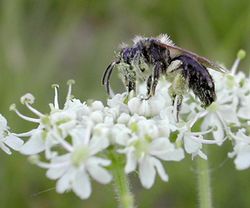Hymenoptera facts for kids
Quick facts for kids Hymenoptera |
|
|---|---|
 |
|
| Andrena sp. | |
| Scientific classification | |
| Kingdom: | |
| Phylum: | |
| Class: | |
| Subclass: | |
| Infraclass: | |
| Superorder: | |
| Order: |
Hymenoptera
|
| Suborders | |
The Hymenoptera is one of the larger orders of insect. It includes the wasps, bees, ants and sawflies. There are over 130,000 recognised species, with many more remaining to be described. The name is derived from the Greek words hymen meaning 'membrane' and ptera meaning 'wings. The hindwings are connected to the forewings by a series of hooks called hamuli.
Females typically have a special ovipositor for inserting eggs into hosts or otherwise inaccessible places. The ovipositor is often modified into a stinger. The young develop through complete metamorphosis — that is, they have a worm-like larval stage and an inactive pupal stage before they mature (See holometabolism).
Sub-order Symphyta
These are the sawflies, the most primitive Hymenoptera. Their adults do not have a narrow 'waist' between the thorax and abdomen. The female's ovipositor is adapted to burrowing or sawing into the substrate, usually plant tissue.
Sub-order Apocrita
These, the bees, wasps and ants, have a 'waist' between the thorax and abdomen. They are by far the most numerous Hymenoptera, and include the famous groups of colonial insects. In fact, the group with the most species is not colonial; it is the vast number of parasitoid wasps, such as the Ichneumons.
Evolution
Hymenoptera originated in the Triassic: the oldest fossils belong to the Sawfly family Xyelidae. Social hymenopterans appeared during the Cretaceous.
Images for kids
-
Bombus muscorum drinking nectar with its long proboscis
-
Symphyta, without a waist: the sawfly Arge pagana
-
Apocrita, with narrow waist: the wasp Vespula germanica
See also
 In Spanish: Himenópteros para niños
In Spanish: Himenópteros para niños




